Servicios Personalizados
Articulo
Indicadores
Links relacionados
-
 Citado por Google
Citado por Google -
 Similares en Google
Similares en Google
Compartir
Journal of Energy in Southern Africa
versión On-line ISSN 2413-3051
versión impresa ISSN 1021-447X
J. energy South. Afr. vol.24 no.4 Cape Town abr. 2013
RESEARCH ARTICLE
Performance analysis of an air humidifier integrated gas turbine with film air cooling of turbine blade
Alok K MahapatraI; B E SanjayII
IDepartment of Mechanical Engineering, Nalanda Institute of Technology, Bhubaneswar, India
IIDepartment of Mechanical Engineering, National Institute of Technology, Jamshedpur, India
ABSTRACT
A computational analysis to investigate the effects of compressor pressure ratio, turbine inlet temperature, ambient relative humidity and ambient temperature on the performance parameters of an air cooled gas turbine cycle with evaporative cooling of inlet air has been presented. The blade cooling method selected is film cooling. The analysis indicates that the mass of coolant required for blade cooling is reduced with increase in temperature drop across the humidifier. Both decrease in ambient temperature and ambient relative humidity results in an increase in plant efficiency and plant specific work. The highest efficiency is obtained at a turbine inlet temperature of 1500 K for all range of ambient relative humidity and ambient temperature, beyond which it decreases. The compressor pressure ratio corresponding to the maximum plant specific work, however, varies with both ambient relative humidity and ambient temperature. The increase in specific work due to drop in ambient relative humidity is more pronounced at higher pressure ratios. Similarly, the increase in efficiency due to ambient temperature drop is prominent at higher turbine inlet temperatures. Finally, a design nomograph is presented to select the design parameters corresponding to best efficiency and specific work.
Keywords: inlet-air cooling, air-humidifier, gas turbine, evaporative cooling, parametric analysis, air-film blade cooling.
Nomenclature
a = ratio of mass of coolant to mass of gas flow
a,b,c = constants
cp = specific heat (kJ-kg-1.K-1)
fh = correction factor to account for vapor added in humidifier
F = factor
Fsa = correction factor to account actual blade surface
gt = gas turbine
h = specific enthalpy (kJkg-1)
ΔHr = lower heating value (kJ.kg-1)
m = mass flow rate (kgs-1)
Q = heat energy transfer (W)
rp = cycle pressure ratio
R = gas constant (kJ-kg-1.K-1)
p = total pressure (bar)
S = blade perimeter (m)

t = pitch of blade (m)
T = temperature (K)
TIT = turbine inlet temperature (K) = combustor exit temperature
W = specific work (kJkg-1)
t a = air temperature (oC)
Greek symbols
Φ = relative humidity (ratio)
ω = specific humidity (kg/kg)
α = gas flow discharge angle (degree)

η = efficiency (%)
Subscripts
a = air, ambient
av = average
b = blade
c = compressor
comb= combustor
dr = drop
e = exit
f = fuel
g = gas
alt = alternator
gt = gas turbine
h = humidifier
I = inlet, stage of compressor
in = inlet
inc = increase
j = coolant bleed points
net = difference between two values
p = pressure
plant = gas turbine plant
pt = polytropic
sat = saturation
vap = water vapor
v = volume .........(m3)
w = water
Acronym
AFC = Air film cooling
AHIGT = Air humidifier integrated gas turbine
C = Compressor
CC = Combustion chamber
GT = Gas turbine
RH = relative humidity (ratio)
1. Introduction
Gas turbines have gained widespread acceptance in the power generation, mechanical drive, and gas transmission markets. The gas turbine cycle burning natural gas (NG) as fuel, gives high efficiency, large output, and reduced emission. Major power plant equipment manufacturers are currently undertaking high profile development programs of gas turbines. The present state-of-the-art gas turbine plant (LMS100) employing an intercooled gas turbine, yields simple cycle thermal efficiency of the order of 47 per cent based on a lower heating value analysis. The efficiency of the gas turbine cycle has been improved mainly due to combination of many factors e.g. increased firing temperature, increased pressure ratio, improved component design, cooling and combustion technologies, and advanced materials and system integration (e.g. combined cycles, intercooling, recuperation, reheat, chemical recuperation) etc.
Wright and Gibbons (2007) have thoroughly reviewed the recent developments in gas turbine materials and technologies. Consequently, thermal efficiencies are currently very attractive, with simple cycle efficiencies ranging between 32% and 42 % and combined cycle efficiencies reaching the 60% mark. The efficiency of the gas turbine cycle has been improved mainly due to enhanced gas turbine performance through advancements in materials and cooling methods in recent years.
The two important methods of improving the gas turbine performance are by inlet air cooling and gas turbine blade cooling. The highest losses of power due to increase in the ambient air temperature in gas turbine power output usually coincide with periods of high electricity demand. A gas turbine loses approximately 7% of its nominal power when the intake temperature increases from 15 oC, ISO conditions, to 25 oC, and in cases such as in summer when the ambient temperature increases above 25 oC, the losses are still bigger, reaching even 15% of the power rating with 36 oC. By the addition of an air-cooling system at the compressor intake, the inlet air can be conditioned to lower temperatures than ambient, thus improving plant performance at high ambient temperatures. As the inlet air temperature drops, compressor work decreases and so the network and cycle efficiency increases. In addition, air density increases with drop in inlet temperature, which results in an increase in mass flow rate of air entering the compressor and so the power output is further enhanced.
De Lucia et al. (1995) have studied gas turbines with inlet air cooling and concluded that evaporative cooling could enhance the power produced by up to 4% per year. Hosseini et al., (2007) summarized that the output of a gas turbine of the Fars combined cycle power plant at 38 oC ambient temperature and 8% relative humidity is 11 MW more, and the temperature drop of the inlet air is about 19 0C with media evaporative cooling installations. Zadpoor and Nikooyan (2009) have concluded that evaporative inlet cooling systems do not work well in humid areas. Najjar (1996) analyzed that the addition of absorption inlet cooling improves the power output by about 21%, overall thermal efficiency by about 38 % and overall specific fuel consumption by 28%. Bassily (2001) carried out energy balance analysis of gas turbine cycles and reported that introducing indirect inlet air cooling, evaporative after cooling of the compressor discharge along with regeneration, intercooling, and reheat increase the performance significantly. Wang and Chiou (2004) calculated that the expected benefits from the inclusion of the inlet cooling feature is about 12% increase in power output and 5.16% increase in efficiency when the ambient temperature is cooled from 305 K to 283 K. Bassily (2001) presented the effect of evaporative inlet and after cooling on the performance of recuperated gas turbine cycle and showed that evaporative inlet cooling could boost the efficiency of the recuperated cycle by up to 3.2%. Alhazmy and Najjar (2004) have analysed the inlet air chilling using a cooling coil and observed that the cooling coil improves the turbine output by 10% during cold humid conditions and by 18% during hot humid conditions.
However, net power generated from the plant drops by 6.1% and 37.6%, respectively. Kakaras et.al., (2004) presented a computer simulation of an inlet air cooling method and reported that the integration of absorption inlet cooling demonstrates higher power and efficiency compared to evaporative cooling for simple gas turbines.
The search for a better performance of gas turbine engines has also led to adoption of higher turbine inlet temperatures. However, the maximum value of TIT is restricted by metallurgical limits of turbine blade material, which should be kept at 1123 K in order to protect the blades from damage. The turbine inlet temperature TIT could be raised above this limit by using especial high temperature materials or cooling the hot turbine components with a suitable coolant. The objective of the blade cooling is to keep the blade temperature to a safe level, to ensure a long creep life, low oxidation rates, and low thermal stresses. The universal method of blade cooling is by air bled from compressor flowing through the internal passages in the blades.
Work in this area has been done by Louis et al., (1983), Wu and Louis [1984], El-Masri (1986), El-Masri (1988), Briesh et al,. (1995), Bolland and Stadaas (1995), Bolland (1991), Chiesa and Macchi (2002),Dechamps (1998), and Sanjay et al., (2007), Sanjay et al., (2008), Sanjay et al., (2009) and Sanjay (2011). Nevertheless, Horlock et al., (2001) have argued that the efficiency benefits of higher temperatures may be more than offset by the increased losses associated with the cooling flow rates required. Also increasing TIT increases NOx emission and so necessary control mechanism must be employed to keep this NOx emission within permissible limits. This increase in coolant mass flow requirement and emission of NOx gases with adoption of higher TIT can be substantially reduced by the integration of inlet air cooling systems to gas turbines and combined cycle plants. It is therefore interesting to investigate the effect of integration of inlet air cooling to cooled gas turbine based combined cycle plant
It is observed from a study in the cited literatures that none of the previous work has investigated the simultaneous effect of compressor inlet air-cooling and gas turbine blade cooling on the performance of a gas turbine cycle. It is interesting to note that the mass of coolant required for gas turbine blade cooling is a function of inlet air temperature and reduces with increase in temperature drop.
The present work is an attempt in this direction dealing with the combined effect of turbine blade cooling and evaporative inlet air-cooling on the performance of basic gas turbine cycle. The effects of compressor pressure ratio, turbine inlet temperature, ambient relative humidity and ambient temperature have been observed on the thermodynamic performance parameters of the cycle. Figure 1 shows the schematic diagram of a basic gas turbine cycle with inlet air humidifier and is being called air humidifier integrated gas turbine (AHIGT).
2. Modelling of governing equations
Parametric study of the combined cycle using different means of cooling has been carried out by modeling the various elements of a gas turbine cycle using the governing equations. The following are the modeling details of various elements.
2.1 Gas model
The specific heat of real gas varies with temperature and also with pressure at extreme high pressure levels. However, in the present model, it is assumed that specific heat of gas varies with temperature only and is given in the form of polynomials as follows:

where a, b, c, and d are coefficient of polynomials, as taken from the work of Touloukian and Tadash (1970) and fh is the humidity correction factor to account for the increase in specific humidity of ambient air across the air-humidifier:

where Φh,e is the relative humidity at the outlet of humidifier.
Thus, the enthalpy of gas is expressed as:

The enthalpy of ambient air entering the air-humidifier is assigned zero value. In the gas model, natural gas (NG) is the fuel used in combustors and the composition and physical properties (such as ,etc.) of burnt gas composition depend upon the composition of NG that may vary from well-to-well (i.e. the source of NG). For this thermodynamic study, the fuel composition is taken as CH4 = 86.21 %, C2H6 = 7.20 %, and CO2 = 5.56 %, and N2 = 1.03 % by weight.
2.2 Humidifier model
Cooling in a hot, relatively dry climate can be accomplished by evaporative cooling. Evaporative cooling involves passing air across a spray of water or forcing air through a soaked pad that is kept replenished with water (Moran and Shapiro, 1995). Owing to the low humidity of entering air, a part of the water injected evaporates. The energy required for evaporation is provided by the air stream, which is undergoes a reduction in temperature.
The following assumptions are made in the humidifier model:
- The relative humidity at the humidifier outlet is 95%
- The pressure drop of air in the humidifier is 1% of the ambient air pressure.
Applying the mass balance equation across the humidifier control volume boundary gives

where ω is the specific humidity and is calculated at a certain temperature as

where pvap = Φpsat is the partial pressure of vapour, Φ is the relative humidity and psat is the saturation pressure of air corresponding to the desired temperature.
The energy balance equation for the humidifier is given by

Where ha,e and ha,i are the enthalpy of moist air at outlet and inlet of the air humidifier respectively and are calculated as follows:
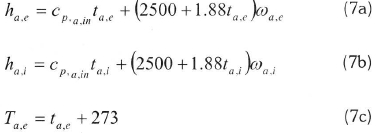
The equations (4 - 7) can be solved to determine the value of Ta,e, wa,e and mw
2.3 Compressor model
The compressor used in a gas turbine power plant is of the axial flow type. The thermodynamic losses in an axial flow compressor are incorporated in the model by introducing the concept of polytropic efficiency. The temperature and pressure of air at any section of compressor are related by the expression:

where Npt,c is the compressor polytropic efficiency and cp,c and Rc are the specific heat at constant pressure and the gas constant across the compressor respectively. Rc is given by

where

where cp,a and cv,a are the specific heats of air at constant pressure and at constant volume respectively, both in kJ/kg K, and are evaluated at the average temperature across the compressor from the following relations (Moran and Shapiro, 1995):
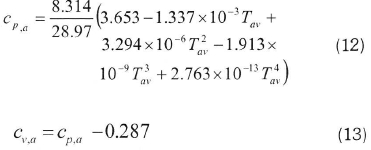
where cp,vap and cv,vap are the specific heats of water-vapor at constant pressure and at constant volume respectively, both in kJ/kg K, and are evaluated at the average temperature across the compressor from the following relations (Moran and Shapiro, 1995):
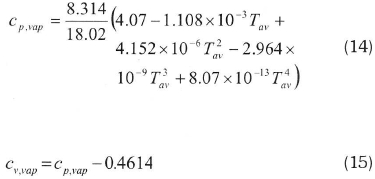
The enthalpy at any polytropic stage of compressor may be calculated using equations (1) , (3), and (8).
Using mass and energy balance across control volume of compressor, the compressor work is calculated as follows:

2.4 Combustor model
Losses inside the combustor, which arise due to incomplete combustion and pressure losses are taken into account by introducing the concept of combustion efficiency and percentage pressure drop of compressor exit pressure (Table 1). The mass and energy balances across the control volume of combustor yield the mass of fuel required to attain a specified exit temperature of combustor, which is taken as TIT, given by:

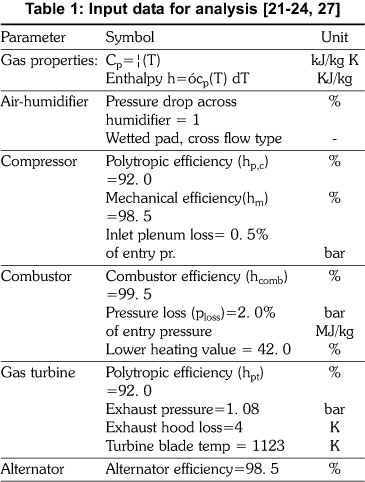
2.5 Cooled gas turbine
Unlike steam turbine blading, gas turbine bladings need cooling. The objective of the blade cooling is to keep the "blade temperature to a safe level, to ensure a long creep life, low oxidation rates, and low thermal stresses. The universal method of blade cooling is by air bled from the compressor flowing through the internal passages in the blades. In the case of film cooling, the coolant exits from the leading edge of blade and a film is formed over the blade surface, which reduces the heat transfer from the hot gas to the blade surface.
In this work, the gas turbine blades have been modeled to be cooled by the air-film cooling (AFC) method. The cooling model used for cooled turbine is the refined version of that by Louis et al. The mass flow rate of coolant required in a blade row is expressed as (Sanjay, 2011):
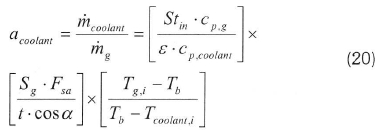
where S g ≅ 2c, Sg/tcosα=3. 0, Fs,a = 1. 05, α = 45° (for stator), α= 48° (for rotor), Stin=0. 005
Also blade coolant requirement is dependent on the temperature of coolant air at the bleed points, which in turn, is dependent upon the temperature of air at the compressor inlet. With a drop in temperature of air at the inlet of compressor achieved in the humidifier, there is a proportionate drop in the temperature of bled coolant due to more effective blade cooling achieved by lower temperature bled coolant and hence lesser coolant requirement. Also, as the mass of bled coolant is less, hence the quantum of pumping and mixing loss associated with the mixing of coolant stream with main gas stream is also less.
Figure 2 gives the details of expansion process for a cooled turbine stage. Process b1-c1 in Figure 2 depicts cooling due to heat transfer between hot gas and coolant, which takes place at constant pressure line due to which exergy decreases, while process c1-d1 depicts drop in temperature due to mixing of coolant with gas which is an irreversible process and also takes place along constant pressure line, which leads to drop in entropy. Process d1-a2 in the model denotes a process similar to throttling.
The deviation between actual and theoretical value is driven by the amount of coolant and coolant temperature used for cooling of blades and the actual value varies with blade cooling requirements. At TIT 1700K for air-film cooling, its maximum value is ±6% (Sanjay, 2011). Turbine work and exergy destruction are given by the mass, energy and exergy balance of gas turbine as under:

3. Performance parameters
The performance parameters Wgt,net, Wplant, and ηplant are expressed as follows:
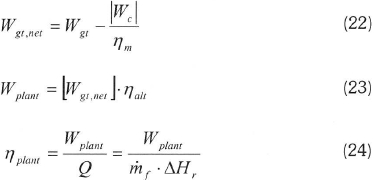
Modeling of cycle components and governing equations developed for cycles proposed have been coded using C+ + and results obtained. A flowchart of the programme code 'Simucomb' illustrating the method of solution is detailed in an earlier article (Sanjay 2011). The input data used in the analysis is given in Table 1.
4. Result and discussions
The influence of evaporative inlet air cooling on gas turbine performance has been shown through the performance curves, plotted using modeling, governing equations and input parameters (Table 1).
Fig. 3(a) shows the effect of inlet cooling on the variation of coolant mass required for blade cooling with respect to ambient temperature. It is evident from the results that the coolant mass required increases with increase in ambient temperature for both the cases. However, as the ambient temperature increases for a given RH, the effectiveness of the cooling is also increased due to a higher saturation pressure and, as a result, the increase in the mass of coolant required for turbine blade cooling is less for a given rise in temperature in case of inlet cooled gas turbine.
Figure 3(b) shows the effect of CIT on mass of blade coolant required and mass of fuel requirement for EVGT configuration. It is observed that as the CIT is reduced, and the blade coolant mass flow rate decreases. This is because, with a drop in temperature of air at the inlet of compressor, that is achieved in the refrigeration system, there is a proportionate drop in the temperature of bled coolant due to more effective blade cooling achieved by lower temperature bled coolant and, hence, lesser coolant requirement. However, due to the reduction in the CIT, the rise in temperature required to be achieved in the CC increases (for a given TIT). This requires a higher amount of heat to be supplied in the CC and so mass of fuel input increases.
Figure 4 shows the benefit of inlet cooled GT cycle over the basic GT cycle without inlet cooling in terms of enhancement in plant efficiency. It is observed that when the relative humidity is decreased for a given ambient temperature, the effi- ciency of inlet cooled GT cycle is increased due to higher drop in temperature achieved in the evaporator whereas the efficiency without inlet cooling almost remains unaltered. It can also be concluded from the results that for a given ambient relative humidity as the ambient temperature increases though the efficiency is reduced for both the cases the improvement in efficiency obtained due to inlet cooling is increased. This is due to the fact that at higher ambient temperature the difference between wet and dry bulb temperature is higher resulting in more effective cooling leading to larger temperature drop in the humidifier and lesser amount of coolant requirement as discussed for Figure 3(a).

Figure 5 shows the effect of TIT on plant efficiency at different ambient temperature. It is observed that the efficiency reduces with increase in temperature. This is because at higher ambient temperature though the drop in temperature is higher owing to higher difference between WBT and DBT, the compressor inlet temperature is also high. A drop of 20o C at an ambient temperature of 318K results in a CIT of 298K against a CIT of 284K at an ambient temperature of 288K where the temperature drop is only 8oC. However, the reduction in efficiency at higher ambient temperature becomes less pronounced compared to basic gas turbine due to inlet cooling. It is also found from the results that the rate of increase in efficiency is higher at higher TIT. The inlet air cooling boosts the efficiency by 3. 51 % at a TIT of 1300K (rp,c=25, RHa=0. 2) when the ambient temperature drops by 300 C. This enhancement increases to 4. 22% for a TIT of 1800K at the same value of rp,c, RHa and ambient temperature drop. .
Figure 6 shows the variation of rp,c and increase in RH of air achieved in the humidifier on plant specific work. It is clearly seen that the specific work increases with increase in specific humidity of air achieved in the humidifier, the enhancement being higher at higher value of rp,c. The specific work increases by 11. 62% at rp,c=28 against an increase of 8. 4% at rp,c=16 for same increase in RH of air achieved in the humidifier. The effect of variation of rp,c on turbine specific work suggests that specific work slightly increases with increase in pressure ratio for all range of specific humidity after which it decreases. It is also observed that the rp,c corresponding to maximum specific work increases with decrease in ambient relative humidity. This suggests that for a higher value of plant specific work there exists an optimum rp,c (for a given increase in RH achieved in the humidifier) and the rp,c needs to be chosen.
Figure 7 shows the variation of rp,c and Ta on specific fuel consumption and plant specific work of an AHIGT cycle. An increase in the specific work and decrease in specific fuel consumption is observed with decrease in Ta This is because at higher temperature though the temperature drop in humidifier is higher, the compressor inlet temperature is also high. The specific fuel consumption decreases by 4. 29% at rp,c=28 against a decrease of 3. 66% at rp,c=16 for same range of ambient temperature drop. The effect of variation of rp,c on turbine specific work suggests that specific work increases with increase in pressure ratio for all range of ambient temperature after which it decreases. It is also observed that the rp,c corresponding to maximum specific work is higher at lower ambient temperature. This suggests that for a higher value of plant specific work there exist an optimum rp,c (corresponding to a given ambient temperature) and the same needs to be chosen as per discussions detailed in the previous section.
Figure 8 also called design nomogram, is helpful in selecting the design parameters such as rp,c TIT and cooling means for the best plant efficiency and specific work. The results show that for all pressure ratios, there exist an optimum TIT at which plant efficiency is the maximum. However, plant specific work continues to increase with increase in TIT and decreases with increase in rp,c. The existence of optimum rp,c at any TIT with reference to the maximum plant efficiency is due to the combined effect of many factors. With increasing rp,c and TIT, the compressor work input, the fuel and coolant air requirements increase, however, the gas turbine work also increases but is restricted by the increasing pumping, cooling and mixing losses.

5. Conclusions
Based on the analysis of an air-humidifier-integrated-gas turbine cycle, the simultaneous integration of inlet air cooling and gas turbine blade cooling, the following conclusions can be deduced:
- The mass of coolant required for turbine blade cooling increases with increase in ambient temperature and ambient relative humidity for a gas turbine.
- The plant efficiency increases when inlet cooling using air-humidifier is integrated into a gas turbine plant.
- The enhancement in efficiency and specific work due to inlet-air cooling is higher at higher ambient temperature.
- The rate of increase in efficiency due to drop in ambient temperature is higher at higher value of TIT.
- The plant specific work increases with increase in specific humidity of air achieved in the humidifier and this enhancement is higher at higher value of rp,c
- It is also observed that the rp,c corresponding to maximum specific work increases with decrease in ambient relative humidity.
- An increase in the specific work and decrease in specific fuel consumption is observed with decrease in ambient temperature due to integration with inlet air humidifier. It is also observed that the rp,c corresponding to maximum specific work is higher at lower ambient temperature.
- The design monogram shows that for all pressure ratios, there exists an optimum TIT at which plant efficiency is the maximum.
References
Alhazmy, M. M. , and Najjar, Y. S. H. (2004). Augmentation of gas turbine performance using air coolers. App. Therm. Eng. , 24, 415-429. [ Links ]
Basilly, A. M. (2001). Effects of evaporative inlet and after-cooling on the recuperated gas turbine cycle. App. Therm. Eng. , 21, 1875-1890. [ Links ]
Bassily, A. M, (2001). "Performance improvements of the intercooled reheat regenerative gas turbine cycles using indirect evaporative cooling of the inlet air and evaporative cooling of the compressor discharge, Proceedings of the Institution of Mechanical Engineers Part A, Journal of Power And Energy, Vol. 215, pp: 545-557. [ Links ]
Bolland, O. , and Stadaas, J. F (1995). Comparative Evaluation of combined cycles and gas turbine systems with injections, steam injection and recuperation. ASME Journal of Engineering for Gas Turbines and Power, 117, 138-145. [ Links ]
Bolland, O. (1991). "A comparative evaluation of advanced combined cycle alternatives. " ASME Journal of Engineering for Gas Turbines and Power, 113, 190-197. [ Links ]
Briesh, M. S. , Bannister, R. L. , Diakunchak, I. S. , and Huber, D. J. (1995). A combined cycle designed to achieve greater than 60 percent efficiency. ASME Journal of Engineering for Gas Turbines and Power, 117, 734 -741. [ Links ]
Chiesa, Macchi. (2002). A thermodynamic analysis of different options to break 60 % electrical efficiency in combined cycle power plants. Proc. , ASME Turbo-Expo 2002, ASME, Amsterdam, GT-2002-30663. [ Links ]
Dechamps, P J. (1998). Advanced combined cycle alternatives with latest gas turbines. ASME Journal of Engineering for Gas Turbines and Power, 120, 350-357. [ Links ]
Delucia, M. , Bronconi, R. , and Carnevale, E. (1994). Performance and economic enhancement of cogeneration gas turbines through compressor inlet air cooling. ASME Transactions Journal of Engineering for Gas Turbines and Power, 116, 360-365. [ Links ]
El-Masri, M. A. (1988). GASCAN - An interactive code for thermal analysis of gas turbine systems. ASME Transactions Journal of Engineering for Gas Turbines and Power, 110, 201-209. [ Links ]
El-Masri, M. A. (1986). On thermodynamic of gas turbines cycle - Part-2 - A model for expansion in cooled turbines. ASME Transactions Journal of Engineering for Gas Turbines and Power, 108, 151-159. [ Links ]
Gas Turbine World. (2010). Pequot Publishing Inc. Vol. 32(1). [ Links ]
Horlock, J. H. , Watson, D. T. , and Jones, V. (2001). Limitation on Gas turbine performance imposed by large turbine cooling flows. " ASME Journal of Engineering for Gas Turbines and Power, 123, 487-494. [ Links ]
Hosseini, R. , Beshkani, A. , and Soltani, M. (2007). Performance improvement of gas turbines of Fars (Iran) combined cycle power plant by intake air cooling using a media evaporative cooler, Energy Conversion and Management, 48, 1055-1064. [ Links ]
Kakaras, E. , Doukelis, A. , and Karellas, S. , (2004). Compressor intake-air cooling in gas turbine plants", Energy, 29, 2347-2358. [ Links ]
Louis, J. F , Hiraoka, K. , and El-Masri, M. A. (1983). A comparative study of influence of different means of turbine cooling on gas turbine performance. Proc. , ASME Turbo-Expo 2002, ASME, Amsterdam, 83-GT-180. [ Links ]
Data Series, IFI/PLENUNM, New York, Washington. [ Links ]
Moran, M. , and Shapiro, H. (1995). Fundamentals of Engineering Thermodynamics. John Wiley, New York. [ Links ]
Sanjay, B. E. , Singh, O. , and Prasad, B. N. (2007). Energy and Exergy Analysis of Steam Cooled Reheat Gas-Steam Combined Cycle. App. Therm. Eng. , 27, 2779-2790. [ Links ]
Sanjay, B. E. , Singh, O. , and Prasad, B. N. (2008). Influence of Different Means of Turbine Blade Cooling on the Thermodynamic Performance of Combined Cycle. " App. Therm. Eng. , 28, 2315-2326. [ Links ]
Sanjay, B. E. , Singh, O. , and Prasad, B. N. (2009). Comparative Performance Analysis of Cogeneration Gas Turbine Cycle for Different Blade Cooling Means. Int. Journal of Thermal Sciences, 48(7), 1432-1440. [ Links ]
Sanjay, B. E. (2011). "Investigation of effect of variation of cycle parameters on thermodynamic performance of gas/ steam combined cycle. " Energy, 36, 157-167. [ Links ]
Touloukian, Y. S. , and Tadash, M. (1970). Thermophysical Properties of Matter. Vol. 6, The TPRC [ Links ]
Wang, F. J. , and Chiou, J. S. , (2004). Integration of steam injection and inlet air cooling for a gas turbine generation system, Energy Conversion and Management, 45, 15-26. [ Links ]
Wright, I. G. , and Gibbons, T. B. (2007). Recent developments in gas turbine materials and technology and their implications for syngas firing, International Journal of Hydrogen Energy, 32, 3610 - 3621. [ Links ]
Yousef S. H. Najjar (1996). Enhancement Of Performance Of Gas Turbine Engines By Inlet Air Cooling and Cogeneration System, Applied Thermal Engineering, Vol. 16, No. 2, pp. 163-173. [ Links ]
Zadpoor, A. A. , and Nikooyan, A. A. (2009). "Development of an Improved Desiccant-Based Evaporative Cooling System for Gas Turbines" , ASME Journal of Engineering for Gas Turbines and Power, 131, 034506. [ Links ]
Received 13 December 2011
Revised 25 November 2013














